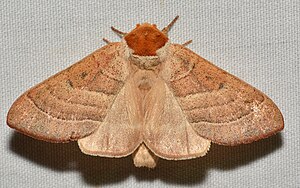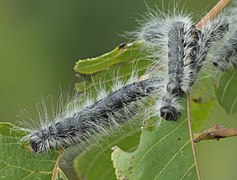Datana integerrima
| Datana integerrima | ||||||||||||
|---|---|---|---|---|---|---|---|---|---|---|---|---|

Datana integerrima |
||||||||||||
| Systematics | ||||||||||||
|
||||||||||||
| Scientific name | ||||||||||||
| Datana integerrima | ||||||||||||
| Grote & Robinson , 1866 |
Datana integerrima is occurring in North and Central America butterfly ( moth ) from the family of notodontidae (Notodontidae).
features
butterfly
The moths reach a wingspan of 35 to 55 millimeters. Females are usually larger than males. The color of the upper forewing varies from reddish gray to reddish brown to light brown and shows four thin dark brown transverse lines. The field between the two innermost transverse lines is usually somewhat darkened. A dark discoid spot is often only faintly indicated. The upper side of the hind wing is unmarked light gray to light reddish brown. The dense red-brown hair of the head and thorax area is striking .
Caterpillar
Young caterpillars are initially red-brown in color and almost hairless. As they develop, they take on a dark gray to black color and develop increasingly dense whitish hairs. The hair does not contain any toxic substances, but if touched it can irritate human skin and lead to itching or a slight rash. The head capsule is glossy black. The caterpillars live tightly packed in nest-like clusters on tree trunks or branches and stay together in groups to eat. They are sometimes attacked by parasitic wasps (Ichneumonidae).
Similar species
While the moths of Datana ministra and Datana major differ only slightly from Datana integerrima by a fifth transverse line and a slightly darker one, and that of Datana perspicua by a lighter overall appearance , the caterpillars of the species mentioned are easy to distinguish, while those of the similar species are strikingly yellow Have drawing elements.
distribution and habitat
Datana integerrima occurs in southeast Canada , in the eastern, southeastern and some central regions of the USA as well as in northern Mexico widespread to local. In Arizona it is represented by the subspecies Datana integerrima cochise . The species primarily inhabits deciduous forests.
Way of life
The nocturnal moths can be found between May and November. In the north they form one, in the middle two and in the southern distribution areas up to three generations per year. You visit artificial light sources . The eggs are white and are deposited in large numbers (up to several hundred) on the underside of leaves of the food plant. The caterpillars feed on the leaves of various walnut plants (Juglandaceae). In the event of a mass occurrence, they are able to defoliate the trees and severely impair the vitality, yield and nut quality of the trees. The earlier the tree is attacked, the greater the damage to the tree. Trees can withstand two or three consecutive years of severe defoliation, but die if the infestation is prolonged. The caterpillars are attacked by many types of parasites , particularly parasitic wasps, and various diseases. This sometimes keeps the number of caterpillars low. The bacterium (Bacteria) Bacillus thuringiensis is occasionally used successfully for biological pest control . As long as the caterpillars are small, their nests are sometimes fought by crushing or burning. The last generation of pupae overwinter in the ground.
Individual evidence
- ↑ a b c Information from Iowa State University on Art
- ↑ dissemination
- ↑ Flight time at iNaturalist
- ↑ a b Pest behavior of the caterpillars
literature
- Grote & Robinson: Lepidopterological notes and descriptions No. 2 , Proceedings of the Entomological Society of Philadelphia 6, 1866, pp. 12/13
Web links
- ITIS Report - Taxonomy
- mothphotographersgroup - Location data based on data from Mississippi State University




